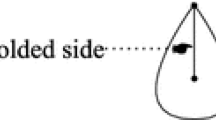Abstract
We introduce the cluster exchange groupoid associated to a non-degenerate quiver with potential, as an enhancement of the cluster exchange graph. In the case that arises from an (unpunctured) marked surface, where the exchange graph is modelled on the graph of triangulations of the marked surface, we show that the universal cover of this groupoid can be constructed using the covering graph of triangulations of the surface with extra decorations. This covering graph is a skeleton for a space of suitably framed quadratic differentials on the surface, which in turn models the space of Bridgeland stability conditions for the 3-Calabi–Yau category associated to the marked surface. By showing that the relations in the covering groupoid are homotopically trivial when interpreted as loops in the space of stability conditions, we show that this space is simply connected.
























Similar content being viewed by others
References
Amiot, C.: Cluster categories for algebras of global dimension 2 and quivers with potential Ann. Inst. Fourier 59, 2525–2590 (2009). arXiv:0805.1035
August, J., Wemyss, M.: Stability on contraction algebras implies \(K(\pi ,1)\). arXiv:1907.12756
Boissy, C.: Connected components of the moduli space of meromorphic differentials. Comment. Math. Helv. 90, 255–286 (2015)
Bridgeland, T.: Stability conditions on triangulated categories. Ann. Math. 166, 317–345 (2007). (arXiv:math/0212237)
Bridgeland, T., Smith, I.: Quadratic differentials as stability conditions. Publ. Math. de l’IHÉS 121, 155–278 (2015). (arXiv:1302.7030)
Brüstle, T., Zhang, J.: On the cluster category of a marked surface without punctures. Algebra Number Theory 5, 529–566 (2011). arXiv:1005.2422
Buan, A.B., Iyama, O., Reiten, I., Smith, D.: Mutation of cluster tilting objects and potentials. Am. J. Math. 133, 835–887 (2011). (arXiv:0804.3813)
Buan, A.B., Qiu, Y., Zhou, Y.: Decorated marked surfaces III: The derived category of a decorated marked surface Int. Math. Res. Not. (to appear). arXiv:1804.00094
Derksen, H., Weyman, J., Zelevinsky, A.: Quivers with potentials and their representations I: mutations. Selecta Mathematica 14, 59–119 (2008). (arXiv:0704.0649)
Farb, B., Margalit, D.: A Primer on Mapping Class Groups. Princeton University Press, Princeton (2012)
Fomin, S., Shapiro, M., Thurston, D.: Cluster algebras and triangulated surfaces, part I: cluster complexes. Acta Math. 201, 83–146 (2008). (arXiv:math/0608367)
Fomin, S., Zelevinsky, A.: Cluster algebras I: foundations. J. Am. Math. Soc. 15, 497–529 (2002). (arXiv:math/0104151)
Guaschi, J., Juan-Pineda, D.: A survey of surface braid groups and the lower algebraic K-theory of their group rings in “Handbook of Group actions, Vol. II”, pp. 23–75. Adv. Lect. in Math. 32, Int. Press, Boston (2015). arXiv:1302.6536
Higgins, P.: Categories and groupoids. Repr. Theory Appl. Categ. 7, 1–195 (2005)
Haiden, F., Katzarkov, L., Kontsevich, M.: Stability in Fukaya categories of surfaces. Publ. Math. de l’IHÉS 126, 247–318 (2017). (arXiv:1409.8611)
Iyama, O., Yoshino, Y.: Mutation in triangulated categories and rigid Cohen–Macaulay modules. Invent. Math. 172, 117–168 (2008). (arXiv:math/0607736)
Keller, B.: On cluster theory and quantum dilogarithm identities. EMS Series of Congress Reports , pp. 85–116 (2011). arXiv:1102.4148
Keller, B.: Cluster algebras and derived categories. EMS Series of Congress Reports, pp. 123–183 (2012). arXiv:1202.4161
Keller, B., Yang, D.: Derived equivalences from mutations of quivers with potential. Adv. Math. 226, 2118–2168 (2011). (arXiv:0906.0761)
King, A., Qiu, Y.: Exchange graphs and Ext quivers. Adv. Math. 285, 1106–1154 (2015). (arXiv:1109.2924)
Kontsevich, M., Zorich, A.: Connected components of the moduli spaces of Abelian differentials with prescribed singularities. Invent. Math. 153, 631–678 (2003). (arXiv:math/0201292)
Krammer, D.: A class of Garside groupoid structures on the pure braid group. Trans. Am. Math. Soc. 360, 4029–4061 (2008). (arXiv:math/0509165)
Labardini-Fragoso, D.: Quivers with potentials associated to triangulated surfaces. Proc. Lond. Math. Soc. 98, 797–839 (2009). (arXiv:0803.1328)
Pauksztello, D., Saorn, M., Zvonareva, A.: Contractibility of the stability manifold for silting-discrete algebras. arXiv:1705.10604
Plamondon, P.-G.: Cluster algebras via cluster categories with infinite-dimensional morphism spaces. Compos. Math. 147, 1921–1954 (2011). (arXiv:1004.0830)
Qiu, Y.: Stability conditions and quantum dilogarithm identities for Dynkin quivers. Adv. Math. 269, 220–264 (2015). (arXiv:1111.1010)
Qiu, Y.: Decorated marked surfaces: spherical twists versus braid twists. Math. Ann. 365, 595–633 (2016). (arXiv:1407.0806)
Qiu, Y.: Decorated marked surfaces (part B): topological realizations. Math. Z. 288, 39–53 (2018)
Qiu, Y.: The braid group for a quiver with superpotential. Sci. China Math. 62, 1241–1256 (2019). (arXiv:1712.09585)
Qiu, Y., Woolf, J.: Contractible stability spaces and faithful braid group actions. Geom. Topol. 22, 3701–3760 (2018). (arXiv:1407.5986)
Qiu, Y., Zhou, Y.: Decorated marked surfaces II: intersection numbers and dimensions of Homs. Trans. Am. Math. Soc. 372, 635–660 (2019). (arXiv:1411.4003)
Qiu, Y., Zhou, Y.: Finite presentations for spherical/braid twist groups from decorated marked surfaces. arXiv:1703.10053
Seidel, P., Thomas, R.: Braid group actions on derived categories of coherent sheaves. Duke Math. J. 108, 37–108 (2001). (arXiv:math/0001043)
Acknowledgements
QY would like to thank Aslak Buan and Yu Zhou for collaborating on the prequels to this paper. He is also grateful to Tom Bridgeland and Ivan Smith for inspiring discussions. This work is supported by Hong Kong RGC 14300817 (from Chinese University of Hong Kong) and Beijing Natural Science Foundation (Z180003).
Author information
Authors and Affiliations
Corresponding author
Additional information
Publisher's Note
Springer Nature remains neutral with regard to jurisdictional claims in published maps and institutional affiliations.
Rights and permissions
About this article
Cite this article
King, A., Qiu, Y. Cluster exchange groupoids and framed quadratic differentials. Invent. math. 220, 479–523 (2020). https://doi.org/10.1007/s00222-019-00932-y
Received:
Accepted:
Published:
Issue Date:
DOI: https://doi.org/10.1007/s00222-019-00932-y



